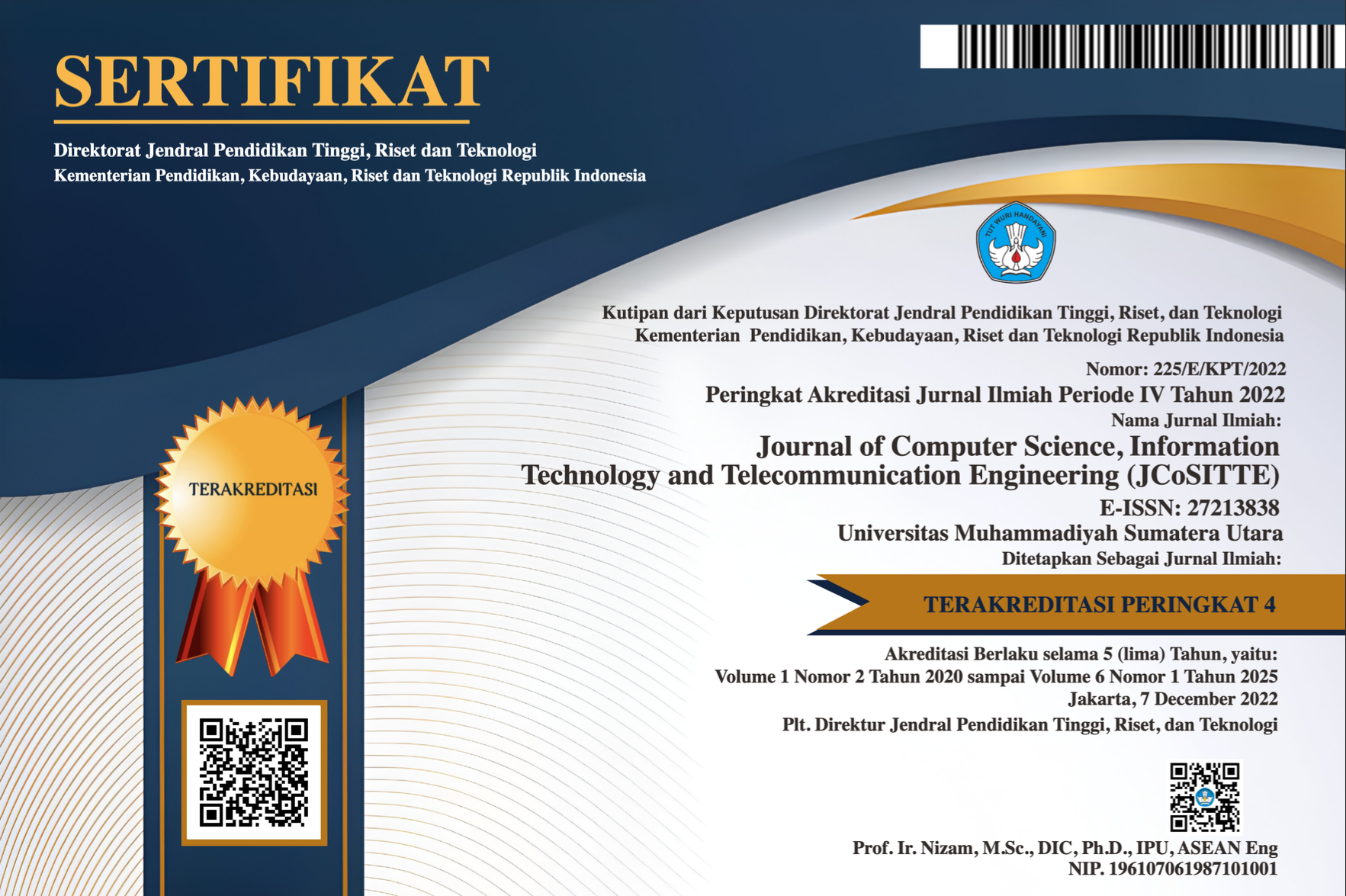Performance Comparison of Boosting Algorithms in Spices Classification Using Histogram of Oriented Gradient Feature Extraction
Abstract
Keywords
Full Text:
PDFReferences
Achyunda Putra, F. A. I., Utaminingrum, F., & Mahmudy, W. F. (2020a). HOG Feature Extraction and KNN Classification for Detecting Vehicle in The Highway. IJCCS (Indonesian Journal of Computing and Cybernetics Systems), 14(3), 231. https://doi.org/10.22146/ijccs.54050
Ali, A., Wu, H., Ponnampalam, E. N., Cottrell, J. J., Dunshea, F. R., & Suleria, H. A. R. (2021). Comprehensive profiling of most widely used spices for their phenolic compounds through lc-esi-qtof-ms2 and their antioxidant potential. Antioxidants, 10(5). https://doi.org/10.3390/antiox10050721
Anggrasari, H., & Mulyo, J. H. (2019). The Trade Of Indonesian Spice Comodities In International Market. Agro Ekonomi, 30(1). https://doi.org/10.22146/ae.41665
Embuscado, M. E. (2015). Spices and herbs: Natural sources of antioxidants - A mini review. Journal of Functional Foods, 18, 811–819. https://doi.org/10.1016/j.jff.2015.03.005
Bakheet, S., & Al-Hamadi, A. (2021). A framework for instantaneous driver drowsiness detection based on improved HOG features and naïve bayesian classification. Brain Sciences, 11(2), 1–15. https://doi.org/10.3390/brainsci11020240
Basha, S. M., Rajput, D. S., & Vandhan, V. (2018). Impact of gradient ascent and boosting algorithm in classification. International Journal of Intelligent Engineering and Systems (IJIES), 11(1), 41-49.
Biology, M. L.-A. of the R. S. for C., & 2021, undefined. (2021). Role of Spices in Food for Immune Boosting. Annalsofrscb.Ro, 25(3), 5841–5853
Bao, T. Q., Kiet, N. T. T., Dinh, T. Q., & Hiep, H. X. (2020). Plant species identification from leaf patterns using histogram of oriented gradients feature space and convolution neural networks. Journal of Information and Telecommunication, 4(2), 140–150. https://doi.org/10.1080/24751839.2019.1666625.
Dorogush, A. V., Ershov, V., & Gulin, A. (2018). CatBoost: gradient boosting with categorical features support. arXiv preprint arXiv:1810.11363.
Ghaffari, S., Soleimani, P., Li, K. F., & Capson, D. W. (2020). Analysis and Comparison of FPGA-Based Histogram of Oriented Gradients Implementations. IEEE Access, 8, 79920–79934. https://doi.org/10.1109/ACCESS.2020.2989267
Girsang, N. D. (2021, February). Classification Of Batik Images Using Multilayer Perceptron With Histogram Of Oriented Gradient Feature Extraction. In Proceeding International Conference on Science and Engineering (Vol. 4, pp. 197-204).
Helmalia, A. W., Putrid, P., & Dirpan, A. (2019). Potensi Rempah-Rempah Tradisional Sebagai Sumber Antioksidan Alami Untuk Bahan Baku Pangan Fungsional). Canrea Journal: Food Technology, Nutritions, and Culinary Journal, 2(1), 26–31. https://doi.org/10.20956/canrea.v2i1.113
Jiang, Y., Tong, G., Yin, H., & Xiong, N. (2019). A pedestrian detection method based on genetic algorithm for optimize XGBoost training parameters. IEEE Access, 7, 118310-118321.
Khairina, N., Sibarani, T. T. S., Muliono, R., Sembiring, Z., & Muhathir, M. (2022). Identification of Pneumonia using The K-Nearest Neighbors Method using HOG Fitur Feature Extraction. JOURNAL OF INFORMATICS AND TELECOMMUNICATION ENGINEERING, 5(2), 562-568.
Muhathir, M., & Santoso, M. H. Muliono. R(2020a). Analysis Naïve Bayes In Classifying Fruit by Utilizing Hog Feature Extraction. Journal of Informatics and Telecommunication Engineering, 4(1), 151–160. https://doi.org/10.31289/jite.v4i1.3860
Muhathir, M., Sibarani, T. T. S., & Al-Khowarizmi, A. K. (2020). Analysis K-Nearest Neighbors (KNN) in Identifying Tuberculosis Disease (Tb) By Utilizing Hog Feature Extraction. Al'adzkiya International of Computer Science and Information Technology (AIoCSIT) Journal, 1(1).
Muhathir, M., Muliono, R., & Hafni, M. (2022). Image Classification of Autism Spectrum Disorder Children Using Naï ve Bayes Method With Hog Feature Extraction. JOURNAL OF INFORMATICS AND TELECOMMUNICATION ENGINEERING, 5(2), 494-501.
Mutiara, T. A., & Azizah, Q. N. (2022). Klasifikasi Tumor Otak Menggunakan Ekstraksi Fitur HOG dan Support Vector Machine. Jurnal Infortech, 4(1), 45–50.
Rizal, R. A., Sihotang, J. S., & Gultom, R. (2019, November). Comparison of SURF and HOG extraction in classifying the blood image of malaria parasites using SVM. In 2019 International Conference of Computer Science and Information Technology (ICoSNIKOM) (pp. 1-6). IEEE.
Sevinç, E. (2022). An empowered AdaBoost algorithm implementation: A COVID-19 dataset study. Computers & Industrial Engineering, 165, 107912
Shaker, B., Yu, M. S., Song, J. S., Ahn, S., Ryu, J. Y., Oh, K. S., & Na, D. (2021). LightBBB: computational prediction model of blood–brain-barrier penetration based on LightGBM. Bioinformatics, 37(8), 1135-1139
Susiarti, S., Rahayu, M., Ningsih, D. Q. W., Arifa, N., & Setiawan, M. (2021). Tanaman Rempah dan Masakan Tradisional di Kelurahan Nanggewer Mekar, Cibinong, Kabupaten Bogor. Jurnal Masyarakat Dan Budaya, 23(3), 337–353. https://doi.org/10.14203/jmb.v23i3.1434.
Tanjung, J. P., & Muhathir, M. (2020). Classification of facial expressions using SVM and HOG. Journal of Informatics and Telecommunication Engineering, 3(2), 210-215.
Yana. (2018). Study Jenis Rempah – Rempah dan Pemanfaatannya di Pasar Tradisional Angso Duo. Skripsi, 125.
Wulandari, I., Yasin, H., & Widiharih, T. (2020). Klasifikasi Citra Digital Bumbu Dan Rempah Dengan Algoritma Convolutional Neural Network (CNN). Jurnal Gaussian, 9(3), 273–282. https://doi.org/10.14710/j.gauss.v9i3.27416
DOI: https://doi.org/10.30596/jcositte.v4i1.13710
Refbacks
- There are currently no refbacks.





.png)

